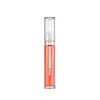What's inside
What's inside
 Key Ingredients
Key Ingredients

 Benefits
Benefits

 Concerns
Concerns

 Ingredients Side-by-side
Ingredients Side-by-side

Hydrogenated Polyisobutene
EmollientDiisostearyl Malate
EmollientOctyldodecanol
EmollientCaprylic/Capric Triglyceride
MaskingEthylhexyl Hydroxystearate
EmollientMenthyl Lactate
MaskingSilica Dimethyl Silylate
Emollient1,2-Hexanediol
Skin ConditioningDextrin Palmitate
EmulsifyingDibutyl Lauroyl Glutamide
Skin ConditioningDibutyl Ethylhexanoyl Glutamide
Skin ConditioningParfum
MaskingCalcium Sodium Borosilicate
CI 77891
Cosmetic ColorantTin Oxide
AbrasiveAnemarrhena Asphodeloides Root Extract
Skin ConditioningPrunus Amygdalus Dulcis Oil
Skin ConditioningHydrogenated Polyisobutene, Diisostearyl Malate, Octyldodecanol, Caprylic/Capric Triglyceride, Ethylhexyl Hydroxystearate, Menthyl Lactate, Silica Dimethyl Silylate, 1,2-Hexanediol, Dextrin Palmitate, Dibutyl Lauroyl Glutamide, Dibutyl Ethylhexanoyl Glutamide, Parfum, Calcium Sodium Borosilicate, CI 77891, Tin Oxide, Anemarrhena Asphodeloides Root Extract, Prunus Amygdalus Dulcis Oil
Methyl Hydrogenated Rosinate
PerfumingDimer Dilinoleyl Dimer Dilinoleate
EmollientPolyglyceryl-2 Triisostearate
EmulsifyingPolyglyceryl-10 Decaisostearate
EmollientJojoba Esters
EmollientPolyglyceryl-3 Beeswax
EmulsifyingGlyceryl Behenate/Eicosadioate
EmollientEthylhexyl Palmitate
EmollientDipalmitoyl Hydroxyproline
Skin ConditioningMenthoxypropanediol
MaskingParfum
MaskingSynthetic Fluorphlogopite
Silica
AbrasivePrunus Avium Seed Oil
EmollientEthyl Vanillin
MaskingTocopherol
AntioxidantTrihydroxystearin
Skin ConditioningCapsicum Frutescens Fruit Extract
Skin ConditioningTin Oxide
AbrasiveSodium Hyaluronate
HumectantGlucomannan
Skin ConditioningCI 77891
Cosmetic ColorantMethyl Hydrogenated Rosinate, Dimer Dilinoleyl Dimer Dilinoleate, Polyglyceryl-2 Triisostearate, Polyglyceryl-10 Decaisostearate, Jojoba Esters, Polyglyceryl-3 Beeswax, Glyceryl Behenate/Eicosadioate, Ethylhexyl Palmitate, Dipalmitoyl Hydroxyproline, Menthoxypropanediol, Parfum, Synthetic Fluorphlogopite, Silica, Prunus Avium Seed Oil, Ethyl Vanillin, Tocopherol, Trihydroxystearin, Capsicum Frutescens Fruit Extract, Tin Oxide, Sodium Hyaluronate, Glucomannan, CI 77891
 Reviews
Reviews

Alternatives
Ingredients Explained
These ingredients are found in both products.
Ingredients higher up in an ingredient list are typically present in a larger amount.
Ci 77891 is a white pigment from Titanium dioxide. It is naturally found in minerals such as rutile and ilmenite.
It's main function is to add a white color to cosmetics. It can also be mixed with other colors to create different shades.
Ci 77891 is commonly found in sunscreens due to its ability to block UV rays.
Learn more about CI 77891Parfum is a catch-all term for an ingredient or more that is used to give a scent to products.
Also called "fragrance", this ingredient can be a blend of hundreds of chemicals or plant oils. This means every product with "fragrance" or "parfum" in the ingredients list is a different mixture.
For instance, Habanolide is a proprietary trade name for a specific aroma chemical. When used as a fragrance ingredient in cosmetics, most aroma chemicals fall under the broad labeling category of “FRAGRANCE” or “PARFUM” according to EU and US regulations.
The term 'parfum' or 'fragrance' is not regulated in many countries. In many cases, it is up to the brand to define this term.
For instance, many brands choose to label themselves as "fragrance-free" because they are not using synthetic fragrances. However, their products may still contain ingredients such as essential oils that are considered a fragrance by INCI standards.
One example is Calendula flower extract. Calendula is an essential oil that still imparts a scent or 'fragrance'.
Depending on the blend, the ingredients in the mixture can cause allergies and sensitivities on the skin. Some ingredients that are known EU allergens include linalool and citronellol.
Parfum can also be used to mask or cover an unpleasant scent.
The bottom line is: not all fragrances/parfum/ingredients are created equally. If you are worried about fragrances, we recommend taking a closer look at an ingredient. And of course, we always recommend speaking with a professional.
Learn more about ParfumTin Oxide is an inorganic oxide used to add opacity and volume to a product. In nature, it is already found in mineral form. The main ore of tin is an opaque and shiny mineral called casseterite.
Tin Oxide helps remove translucency in a product, or make it more opaque. Besides adding opacity, tin oxide is used for bulking to add volume.